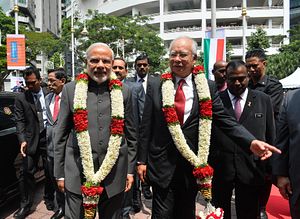Indian Prime Minister Narendra Modi was in Southeast Asia last week, visiting Malaysia and Singapore at a time of great regional turbulence. Modi attended the ASEAN-India Summit and the East Asia Summit in Kuala Lumpur with an aim of not only increasing political, security, and economic cooperation between India and Southeast Asian countries, but also to raise India’s profile in an increasingly important part of the world. Making a direct reference to the South China Sea dispute at the ASEAN-India Summit, Modi took aim at China when he said “India hopes that all parties to the disputes in the South China Sea will abide by the guidelines on the implementation of the Declaration on the Conduct of Parties in the South China Sea, and redouble efforts for early adoption of a Code of Conduct on the basis of consensus.”
At the bilateral level, India and Malaysia pledged to increased bilateral cooperation on a range of defense and security issues, including maritime security, disaster response, and cyber security. Modi and his Malaysian counterpart Najib Razak made combating terrorism a top priority of Indo-Malaysian ties, with Modi praising Razak for his role in combating extremism and radicalization in Malaysia. India’s soft power was also in the mix with Modi highlighting the cultural ties between India with Malaysia as he inaugurated a Torana gate, a traditional gateway to Hindu and Buddhist temples, with the Malaysian Prime Minister.
Next, the Indian prime minister went to Singapore to commemorate the 50th anniversary of diplomatic ties between India and Singapore. Singapore is the second-largest source of foreign direct investment in India, and it is India’s 10th-largest trading partner. Not surprising, therefore, that Modi reached out to investors in Singapore, emphasizing his government’s economic reforms and underlining to an audience of business representatives from over 300 companies that India’s reforms have “successfully restored the credibility of India in the eyes of global players.” Modi projected India as “the most open economy in terms of FDI.” Among the many bilateral pacts with Singapore signed during Modi’s visit, the most significant was the India-Singapore Strategic Partnership Agreement, which is aimed at broadening and deepening ties across various sectors including defense, economics, and capacity-building.
In Malaysia and Singapore, Modi addressed Indian expatriates and rallied them with his call for a greater Indian profile in global affairs, a message he has often repeated in front of similar crowds while on other foreign visits. Indians make up the third largest ethnic group in the city-state, after the Chinese and Malay ethnic groups. Of Malaysia’s total population of nearly 30 million, two million people are of Indian origin.
While and trade and investment remain central to India’s outreach to Southeast Asia, the larger strategic context should not be lost sight of as India engages with the region. With his recent visits, Modi has succeeded in enhancing strategic partnerships with Malaysia and Singapore but New Delhi needs to engage with the region as a whole more substantively. New Delhi needs to assure the regional states of its reliability not only as an economic and political partner, but also as a security provider.
As the regional balance of power in Asia changes and as the very coherence of the ASEAN comes under question, there will be new demands on India. The rapid rise of China in Asia and beyond is the main pivot even as Delhi seeks to expand economic integration and interdependence with the region. India is also developing strong security linkages with the region and trying to actively promote and participate in regional and multilateral initiatives. States in the region are now looking to India not only as an attractive engine for regional growth but also as a balancer in view of China’s growing influence and America’s preoccupations elsewhere. It remains to be seen if India can indeed live up to its full potential, as well as to the region’s expectations.
































